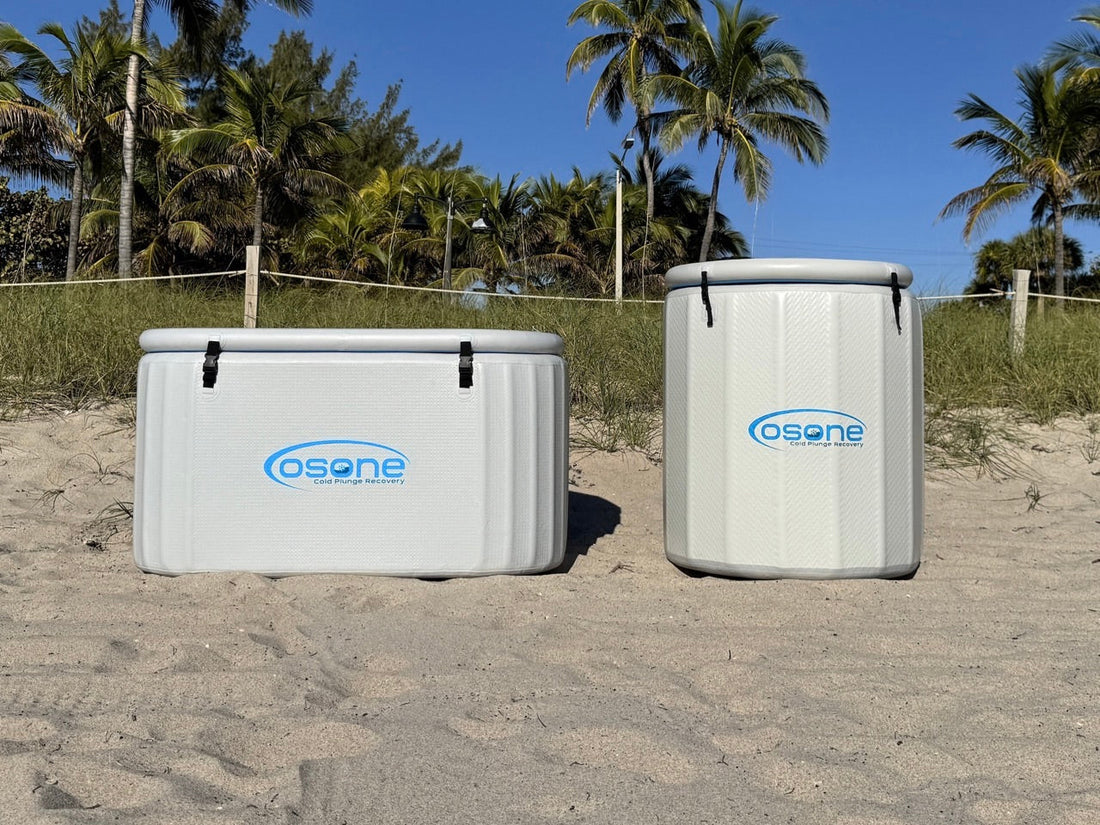At home Cold Plunging typically comes in two styles: the horizontal tub or vertical barrel. Each offers a unique experience with its own advantages and drawbacks. Though the traditional tub is the more common choice, don’t overlook the upright barrel as it may align more intuitively with the body. Not all Cold Plunges deliver the same experience.
Cold Plunge Tub
Cold plunging in a tub involves lying down or sitting in a cold water tub. Ideally, the body is fully submerged in a horizontal position with only the head above water.
Pros
- Ease of Entry & Exit: Entering and exiting the water is easier as the height of the tub is roughly less than 31" in most cases. Every person has used a bathtub sometime in their life so the concept is very familiar.
- Familiar Comfort: The horizontal posture of a plunge tub encourages a more meditative, restful state, reminiscent of traditional bathing experiences, which may help deepen the overall sense of relaxation and stress reduction.
- Designed for Multiple People: With their extended horizontal design, Cold Plunge Tubs provide ample space to accommodate multiple users at once.
Cons
- Slower Cooling Efficiency: Since cold plunge tubs expose more water surface to ambient temperatures, they generally cool down more slowly and struggle to retain cold temperatures as effectively. This impacts both ice consumption and the performance of water chillers.
- Cold-Induced Toe Discomfort: A frequent issue during tub-style cold plunges is numbness in the toes, often caused by their elevated position when legs are extended. Neoprene socks are a popular solution for reducing this discomfort. As with any cold exposure, it's essential to listen to your body and check with your doctor beforehand.
Cold Plunge Barrel
Across many traditional cultures, cold water immersion in natural bodies, such as rivers, lakes, and waterfalls, has been a sacred or ritualistic practice. These immersions often took place in deep waters where individuals stood or crouched, fully submerged from neck to toe. This historical connection are why vertical plunges are often perceived as more "natural" compared to the mainstream horizontal tub setups.
Pros
- Natural Body Posture & Even Water Distribution: In a vertical cold plunge, the water surrounds your entire body, allowing for a more uniform, even distribution of cold temperatures. Standing or crouching upright is also a more instinctive position in natural waters. The setup mirrors environments like rivers, lakes, or oceans, where one stands or wades rather than lays down, avoiding constant contact with the surface behind you which may feel less natural or comfortable for prolonged exposure in ice cold waters.
- Movement Potential: In vertical plunges, you have more freedom to move around since you are not seated on the floor. Movement can help stimulate circulation, and the experience of interacting with the water feels closer to nature than sitting still in a confined tub.
- Space Accommodating: Vertical cold plunge products have a smaller footprint as the circumference is roughly half the floor usage of a cold plunge tub. For those with a tighter footprint, going vertical may be the better option.
- Easier to Breathe: Being upright in a cold plunge barrel makes it easier to breathe as the chest is open and the head is upright, unlike the position in a Cold Plunge Tub where the chin is often tucked into your chest.
-
Enhanced Cooling Efficiency: With less water exposed to ambient air, cold plunge barrels offer superior control over water temperature compared to traditional tubs. This limited surface area helps maintain colder temperatures and accelerates the cooling process, making regulation quicker and more efficient.
Cons
- Challenging Entry & Exit: Entering and exiting a Cold Plunge Barrel requires more effort as the height can easily reach over 3 feet. A step stool outside the cold plunge is often added for ease of entry and exit. Depending on a person's height, a step stool inside may be needed or one will need to have enough upper body strength to lift themselves out of the plunge in order to exit. This setup may be better suited for athletes or agile users with upper body strength.
- Designed for One: With its vertical, space-saving build, the cold plunge barrel is suited for individual use. Tubs, on the other hand, offer more horizontal space and may fit multiple users, depending on their size.
Benefits of both options:
- Manage Pain and Inflammation: The cold around the body can provide a therapeutic effect, beneficial for managing chronic pain and inflammation.
- Enhanced Circulation: Cold plunging helps promote blood circulation throughout the body, improving cardiovascular health.
- Muscle Recovery: Cold immersion reduces muscle inflammation and soreness, particularly beneficial after intense physical activity.
- Mental Resilience: Regular practice strengthens mental fortitude, enhancing one's ability to cope with discomfort and stress.
The choice between a Cold Plunge Tub or Barrel ultimately depends on individual preference. Some prefer a mainstream, traditional tub while others prefer a more natural, vertical setup. If possible, try both before making the investment of buying a cold plunge. You will be surprised how you may prefer one over the other. Regardless of which you choose, cold therapy offers a versatile and invigorating option for those looking to enhance their overall well-being.






